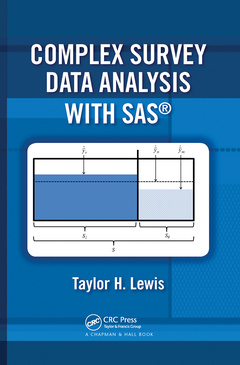Description
Complex Survey Data Analysis with SAS
Author: Lewis Taylor H.
Language: English
Subjects for Complex Survey Data Analysis with SAS:
Keywords
Data Set; PROC SURVEYMEANS; categorical data analysis; PROC SURVEYREG; logistic regression; PROC SURVEYFREQ; survival analysis; PROC SURVEYLOGISTIC; variance estimation; Complex Survey Data; weighting; PROC SURVEYSELECT; imputation; Replicate Weights; Std Error; Taylor Series Linearization; Parameter DF Estimate Standard Error; Var Statement; Auxiliary Variables; Complex Survey; Model Statement; Stratified Simple Random Sampling; Proc Sort Data; Regression Model; PPS Sampling; Person Period Data Set; Imputation Model; Proc Mi; Discrete Time Hazards Model; Proc Surveyselect Data; PROC LIFETEST
Publication date: 12-2021
· 15.6x23.4 cm · Paperback
Publication date: 08-2016
· 15.6x23.4 cm · Hardback
Description
/li>Contents
/li>Biography
/li>
Complex Survey Data Analysis with SAS® is an invaluable resource for applied researchers analyzing data generated from a sample design involving any combination of stratification, clustering, unequal weights, or finite population correction factors. After clearly explaining how the presence of these features can invalidate the assumptions underlying most traditional statistical techniques, this book equips readers with the knowledge to confidently account for them during the estimation and inference process by employing the SURVEY family of SAS/STAT® procedures.
The book offers comprehensive coverage of the most essential topics, including:
- Drawing random samples
- Descriptive statistics for continuous and categorical variables
- Fitting and interpreting linear and logistic regression models
- Survival analysis
- Domain estimation
- Replication variance estimation methods
- Weight adjustment and imputation methods for handling missing data
The easy-to-follow examples are drawn from real-world survey data sets spanning multiple disciplines, all of which can be downloaded for free along with syntax files from the author?s website: http://mason.gmu.edu/~tlewis18/.
While other books may touch on some of the same issues and nuances of complex survey data analysis, none features SAS exclusively and as exhaustively. Another unique aspect of this book is its abundance of handy workarounds for certain techniques not yet supported as of SAS Version 9.4, such as the ratio estimator for a total and the bootstrap for variance estimation.
Taylor H. Lewis is a PhD graduate of the Joint Program in Survey Methodology at the University of Maryland, College Park, and an adjunct professor in the George Mason University Department of Statistics. An avid SAS user for 15 years, he is a SAS Certified Advanced programmer and a nationally recognized SAS educator who has produced dozens of papers and workshops illustrating how to efficiently and effectively conduct statistical analyses using SAS.
Features and Examples of Complex Surveys
Introduction
Definitions and Terminology of Sample Surveys
Overview of SAS/STAT Procedures Available to Analyze Survey Data
Four Features of Complex Surveys
Examples of Complex Surveys
Summary
Drawing Random Samples Using PROC SURVEYSELECTIntroduction
Fundamental Sampling Techniques
Statified Sampling
Cluster Sampling
Summary
Analyzing Continuous Variables Using PROC SURVEYMEANS
Introduction
Totals
Means
Ratios
Quantiles
Summary
Analyzing Categorical Variables Using PROC SURVEYFREQ
Introduction
Univariate Analyses
Bivariate Analyses
Multiway Tables
Summary
Fitting Linear Refression Models Using PROC SURVEYREG
Introduction
Linear Regression in a Simple Random Sampling Setting
Linear Regression with Complex Survey Data
Testing for a Reduced Model
Computing Unit-Level Statistics
Summary
Fitting Logistic Regression Models Using PROC SURVERYLOGISTIC
Introduction
Logistic Regression in a Simple Random Sampling Setting
Logistic Regression with Complex Survey Data
Testing for a Reduced Model and Adequate Model Fit
Computing Unit-Level Statistics
Customizing Odds Ratios
Extensions for Modeling Variables with More than Two Outcomes
Summary
Survival Analysis with Complex Survey Data
Introduction
foundations of Survival Analysis
Survival Analysis with Complex Survey Data
Summary
Domain Estimation
Introduction
Definitions and an Example Data Set
Risk in Subsetting a Complex Survey Data Set
Domain Estimation using Domain-Specific Weights
Domain Estimation for Alternative Statistics
Significance Testing for Domain Mean Differences
Degress of Freedom Adjustments
Summary
Replication Techniques for Variance Estimation
Introduction
More Details Regarding Taylor Series Linearization
Balanced Repeated Replication
Fay's Variant to BRR
Jackknife
Bootstrap
Replication with Liner Models
Replication as a Tool for Estimating Variances of Complex Point Estimates
Degrees of Freedom Adjustments
Summary
Weight Adjustment MethodsIntroduction
Definitions and Missing Data Assumptions
Adjustment Cell Method
Propensity Cell Method
Poststratification
Raking
Summary
Imputation Methods
Introduction
Definitions and a Brief Taxonomy of Imputation Techniques
Multiple Imputation as a Way to Incorporate Missing Data Uncertainty
Univariate Missingness
Multivariate Missingness
Inferences from Multiply Imputed Data
Accounting for Features of the Complex Survey Data during the Imputation Modeling and Analysis Stages
Summary
References
Index
Taylor H. Lewis
These books may interest you

Applied Medical Statistics Using SAS 160.25 €



